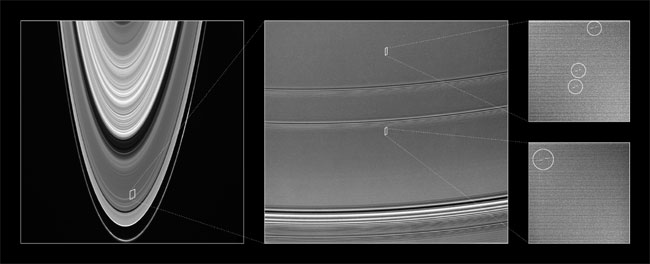
Oddly shaped gaps found in Saturn's rings hint at the existence of long sought "moonlets" and support the theory that the rings are the broken remains of an icy moon shattered long ago in a violent collision, scientists say.
Scientists think a comet or asteroid collided with one of Saturn's moons about 100 million years ago. Such an impact would have created debris in a range of sizes, but until now, scientists only had evidence for chunks of rock that were miles in diameter and smaller particles that were about 65 feet (20 km) across or less. The medium-sized moonlets-so named because their size would be between that of a moon and smaller particles-predicted by theory were missing.
But in July 2004, NASA's Cassini spacecraft was hovering directly above Saturn's ring system when it detected strange gaps resembling S-shaped propellers in the planet's bright A-ring. Scientists think the gaps were formed by chunks of rock 300 feet (100 m) wide as they plowed through smaller particles in the ring.
The finding is detailed in the March 30 issue of the journal Nature.
Propellers in space
The propellers are the result of differences in the speed of material orbiting in Saturn's rings and because of the average size of the moonlets themselves, scientists think. Because the strength of gravity decreases with distance, material circling closer to a planet moves faster than material that is orbiting farther away.
As a result, small ring particles flanking the two sides of an orbiting moonlet would appear to be moving in opposite directions to a viewer standing on a moonlet. Picture three trains moving on parallel tracks but at different speeds. The train on the far left is moving fast; the middle train is moving slightly slower and the train on the far right is moving slowest of all. If an observer in the middle train were to look out her window, the train on her left would appear to be moving forward while the train on her right would look like it was trailing behind.
Breaking space news, the latest updates on rocket launches, skywatching events and more!
The moonlets in Saturn's rings are like the middle train. But because they are so large, the moonlets impede the movement of smaller ring particles to the left and right of them. This creates gaps on their left and right sides.
"Disturbances on one side [of the moonlet] get carried ahead but those on the other get carried behind," explained study leader Matthew Tiscareno from Cornell University. "That's what draws it out into the propeller shape."
The gaps taper off farther away from the moonlets as smaller ring particles gradually refill the empty space.
Scientists think that only intermediate sized rocks can create the propeller shapes. Small particles aren't massive enough to have any effect on their neighbors, while Saturnian moons like Encke and Pan-which are 4 miles (7 km) and 19 miles (30 km) wide, respectively-are so large that their gravity prevents the gaps from closing back up. Through their sheer size, the moons achieve what the moonlets can't: they harrow out rings of empty space that stretch around the entire planet.
More space propellers
The propellers were predicted from computer models but had never been observed in nature before now. They're probably found under other conditions as well, scientists think. In fact, Saturn itself might have created such gaps around the Sun as it formed in the early solar system.
According to the standard theory, planets form from swirling discs of gas, dust and debris around nascent stars. Large chunks of rock and ice in the disc collide and clump together, forming protoplanets and eventually planets.
"The planets in our solar system, the precursors anyway, probably went through this stage," said study team member Derek Richardson from the University of Maryland.
Galaxies like our own Milky Way are also swirling discs of matter that have large objects, such as stars and planets, embedded within them, so could propellers also form in galaxies?
Probably not, Richardson said.
"The analogy in a galactic disc would be a large star with lots of little stars getting strongly perturbed by it," he said. "You don't really see that kind of process operating in galaxies. Stars are far apart."
- Kinks Seen in Theft of Saturn's Ring Material
- Ring Around the Planet: Cassini's First Images of Saturn from Orbit
- ARRIVAL! Cassini Enters Orbit Around Saturn
Join our Space Forums to keep talking space on the latest missions, night sky and more! And if you have a news tip, correction or comment, let us know at: community@space.com.
Ker Than is a science writer and children's book author who joined Space.com as a Staff Writer from 2005 to 2007. Ker covered astronomy and human spaceflight while at Space.com, including space shuttle launches, and has authored three science books for kids about earthquakes, stars and black holes. Ker's work has also appeared in National Geographic, Nature News, New Scientist and Sky & Telescope, among others. He earned a bachelor's degree in biology from UC Irvine and a master's degree in science journalism from New York University. Ker is currently the Director of Science Communications at Stanford University.
